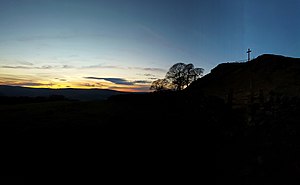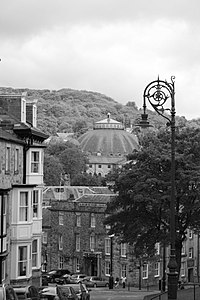Corbar Hill
| Corbar Hill | |||
| Derbyshire | |||
|---|---|---|---|
 Corbar Hill at dusk | |||
| Range: | Peak District | ||
| Summit: | 1,434 feet SK051743 53°15’57"N, 1°55’28"W | ||
Corbar Hill is a sandstone hill at the south end of Combs Moss, overlooking Buxton in Derbyshire, in the Peak District. The summit (marked by a trig pillar) is 1,434 feet above sea level.
The north-west side of the hill (and most of Combs Moss and Black Edge) is designated as "open access" land.
Corbar Cross was a gift from the Duke of Devonshire to Buxton’s Roman Catholics, who erected it at the summit in 1950 to mark the ‘Holy Year’ declared by Pope Pius XII. The cross was painted pink as a prank in the 1990s. Protesters against Pope Benedict XVI's visit to Britain in 2010 cut the cross down. A replacement 20 foot-high solid oak cross was donated by a firm in Lancashire and installed in 2011.[1]
Corbar Woods

Corbar Woods is Buxton's oldest woodland and is included in Buxton's "The Park" conservation area. Its 54 acres are owned and managed by the Buxton Civic Association. The woods were used for coppicing trees in the Middle Ages.
There are remains of a white coal pit, which used dried coppice branches to generate the high temperatures needed to smelt lead.
he 19th-century paths through the ancient woods, known as the Victorian Swiss Walks, were designed by Joseph Paxton (who also laid out the original Buxton Pavilion Gardens). These paths allowed visitors to the spa town to enjoy views over Buxton's fine buildings from the hilltop. The "Ring of Trees" waymarked walk around Buxton runs through Corbar Wood.
The main tree species are beech, yew and oak. The woodland floor at the higher west end of the woods is covered with swathes of bluebells each May. The woods are habitat to common birds (such as thrushes, tits and finches) but are also home to nuthatches and woodpeckers.[2][3][4]
Buildings

Corbar Hill House (on Corbar Road in Buxton) is a Grade II listed building. It was built in the 19th century in the style of a French château (with a mansard roof and fountain), apparently for the Ryder family. It later became John Duncan School, which closed in 2003. It has now been converted into private apartments.[5]
Corbar Hill Hydro was converted from the Clarendon guest house in the 1890s to offer hydropathic treatments. It was sold in the 1930s for nurses' accommodation.[6]
Nithen Quarry on Corbar Hill was used for many years as a source of high-quality sandstone for the buildings of Buxton, including the town hall, which was built in the 1890s.[7]
References
- ↑ "'Iconic' wooden cross is replaced" (in en-GB). BBC News. 20 May 2011. https://www.bbc.com/news/uk-england-derbyshire-13469650.
- ↑ "Woodlands" (in en-GB). https://buxtoncivicassociation.org.uk/woodlands/.
- ↑ "Corbar Wood" (in en-GB). 20 December 2013. https://buxtoncivicassociation.org.uk/corbar-wood/.
- ↑ Morris, Mel (April 2007). "Buxton Conservation Areas Character Appraisal". https://www.highpeak.gov.uk/media/220/Buxton-area-character-appraisal-adopted-April-2007/pdf/HP_CAA.pdf.
- ↑ National Heritage List 1259375: John Duncan School Wye House (Grade II listing)
- ↑ Leach, John (1987). The Book of Buxton. Baracuda Books Limited. pp. 77, 84, 125. ISBN 0 86023 286 7.
- ↑ Morten, David (2018). Buxton in 50 Buildings. Amberley Publishing Limited. ISBN 9781445678948.